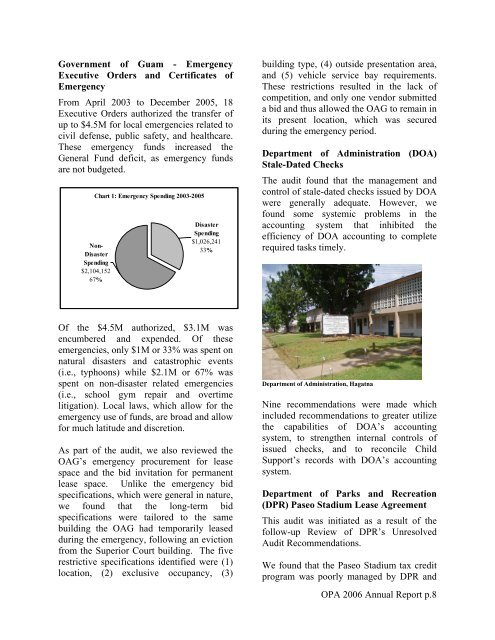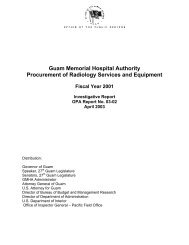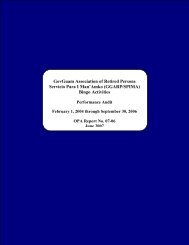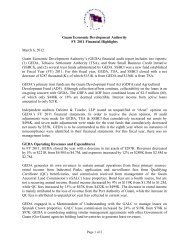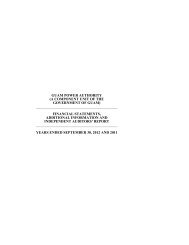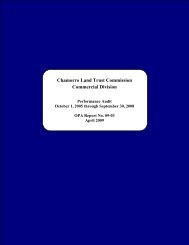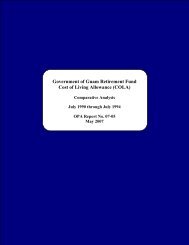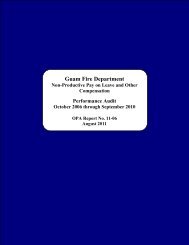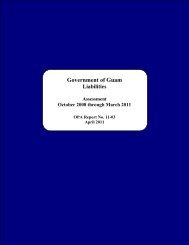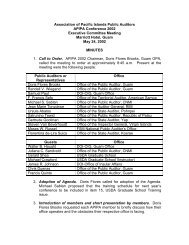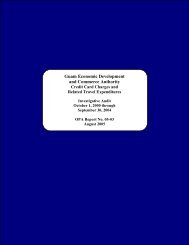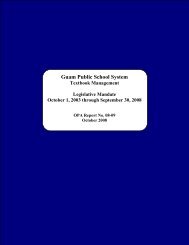2006 - The Office of Public Accountability
2006 - The Office of Public Accountability
2006 - The Office of Public Accountability
Create successful ePaper yourself
Turn your PDF publications into a flip-book with our unique Google optimized e-Paper software.
Government <strong>of</strong> Guam - Emergency<br />
Executive Orders and Certificates <strong>of</strong><br />
Emergency<br />
From April 2003 to December 2005, 18<br />
Executive Orders authorized the transfer <strong>of</strong><br />
up to $4.5M for local emergencies related to<br />
civil defense, public safety, and healthcare.<br />
<strong>The</strong>se emergency funds increased the<br />
General Fund deficit, as emergency funds<br />
are not budgeted.<br />
Chart 1: Emergency Spending 2003-2005<br />
Non-<br />
Disaster<br />
Spending<br />
$2,104,152<br />
67%<br />
Disaster<br />
Spending<br />
$1,026,241<br />
33%<br />
building type, (4) outside presentation area,<br />
and (5) vehicle service bay requirements.<br />
<strong>The</strong>se restrictions resulted in the lack <strong>of</strong><br />
competition, and only one vendor submitted<br />
a bid and thus allowed the OAG to remain in<br />
its present location, which was secured<br />
during the emergency period.<br />
Department <strong>of</strong> Administration (DOA)<br />
Stale-Dated Checks<br />
<strong>The</strong> audit found that the management and<br />
control <strong>of</strong> stale-dated checks issued by DOA<br />
were generally adequate. However, we<br />
found some systemic problems in the<br />
accounting system that inhibited the<br />
efficiency <strong>of</strong> DOA accounting to complete<br />
required tasks timely.<br />
Of the $4.5M authorized, $3.1M was<br />
encumbered and expended. Of these<br />
emergencies, only $1M or 33% was spent on<br />
natural disasters and catastrophic events<br />
(i.e., typhoons) while $2.1M or 67% was<br />
spent on non-disaster related emergencies<br />
(i.e., school gym repair and overtime<br />
litigation). Local laws, which allow for the<br />
emergency use <strong>of</strong> funds, are broad and allow<br />
for much latitude and discretion.<br />
As part <strong>of</strong> the audit, we also reviewed the<br />
OAG’s emergency procurement for lease<br />
space and the bid invitation for permanent<br />
lease space. Unlike the emergency bid<br />
specifications, which were general in nature,<br />
we found that the long-term bid<br />
specifications were tailored to the same<br />
building the OAG had temporarily leased<br />
during the emergency, following an eviction<br />
from the Superior Court building. <strong>The</strong> five<br />
restrictive specifications identified were (1)<br />
location, (2) exclusive occupancy, (3)<br />
Department <strong>of</strong> Administration, Hagatna<br />
Nine recommendations were made which<br />
included recommendations to greater utilize<br />
the capabilities <strong>of</strong> DOA’s accounting<br />
system, to strengthen internal controls <strong>of</strong><br />
issued checks, and to reconcile Child<br />
Support’s records with DOA’s accounting<br />
system.<br />
Department <strong>of</strong> Parks and Recreation<br />
(DPR) Paseo Stadium Lease Agreement<br />
This audit was initiated as a result <strong>of</strong> the<br />
follow-up Review <strong>of</strong> DPR’s Unresolved<br />
Audit Recommendations.<br />
We found that the Paseo Stadium tax credit<br />
program was poorly managed by DPR and<br />
OPA <strong>2006</strong> Annual Report p.8


